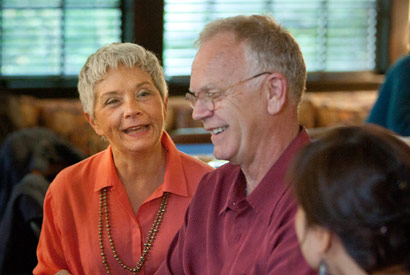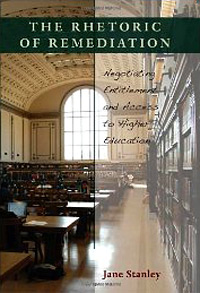Berkeley’s writing requirement? Bold vision, endless revision
College Writing Programs, or CWP, has come a long way from its 19th-century origins, when students were schooled in Subject A, "Oral and Written Expression." The 21st-century Berkeley program offers more than 20 courses in everything from public speaking, creative nonfiction and travel writing to new media.
January 31, 2012
College Writing Programs at Berkeley is, for the record, a singular proper noun. And no, that will not be on the final exam.
There is, for the record, no final exam. Even in R1A, a required class for every Berkeley undergrad who hasn’t passed the state’s standardized writing-placement test, students spend the semester compiling a portfolio of papers, journals and other writing assignments — their own compositions in turn serving as class texts, to be analyzed and, especially, revised.

Jane Stanley and Steve Tollefson (Bruce Cook photo)
“Part of our philosophy is that students learn to write by writing, writing, writing,” says Jane Stanley, a veteran writing teacher and the program’s associate director. Stanley, who recently published a book on the history of so-called remedial writing in California, utters the phrase “endless revisions” with an italicized, writerly relish. She estimates that the 14 students in each section of R1A, Accelerated Reading and Composition — the program has “special dispensation,” she says, to limit classes to workshop size — produce five papers apiece per semester, each paper receiving an average of three revisions.
College Writing Programs is not, in short, your grandparents’ writing program. Grammar and syntax still apply, and still matter. But CWP has come a long way from its 19th-century origins, when UC students were schooled in “Oral and Written Expression” — known universitywide as Subject A — defined as the ability to use English “correctly, clearly and pertinently.” In addition to such longtime staples as reading and comp and professional communication, the 21st-century Berkeley program offers more than 20 courses in everything from public speaking, creative nonfiction and travel writing to new media, where advanced students learn concision by crafting 130-character micro-essays suitable for Twitter.
“To me, it’s everything about life,” says Steve Tollefson, who’s taught writing on campus for nearly 40 years — long enough, in theory, to have taught the grandparents of his current students. Tollefson, who gave up grad school for a storied Berkeley career, adds the exclamation mark to Stanley’s unmistakable excitement for the mission of College Writing. “I get a little messianic,” he admits.
Known for spearheading such campus programs as Berkeley Writers at Work and the Distinguished Teaching Award — he was a recipient in 1984, and later picked up a Berkeley Citation — Tollefson retired last July from the administrative side of campus life. But he remains an instructor in, and unabashed champion of, CWP.
“When I first started teaching our focus was grammar and structure,” says Tollefson, the author of four books on writing. “Now it’s really analysis and critical thinking.”
He and Stanley agree that the 21st-century program’s wide-ranging course offerings provide students with not just the nuts and bolts of composition, but a foundation for success in school, in work and in life.
“Students speak of having more confidence, of having learned what it takes to complete a senior thesis,” says Stanley, who recently plowed through thousands of teacher-evaluation forms turned in by writing students over the past three years. “‘I know how to make an argument’ — that showed up again and again. A lot of people mention the mechanical things, ‘Now I can write more clearly’ and so forth. But ‘I know how to say what I want to say’ — those are the ones I really love.”
The “big learning curve” for today’s students is “how much time it takes to write well,” Stanley says. Revising “isn’t just proofreading or checking your grammar, but rethinking what you want to say.”
Her hope is to create a series of research courses on different topics modeled on “Researching Water in the West,” an outgrowth of CWP instructor Pat Steenland’s reading-and-comp section, which included a tour of the Bancroft Library archives. “Being with all those old materials,” Stanley says, “her students were amazed.” For College Writing Programs, the lesson was that “the subject of water in California was rich enough to engage students from all kinds of disciplines to write and research in all kinds of genres.”
Changing perceptions
All told, the program’s two dozen lecturers now provide instruction to 700 students a semester, about 300 of them in freshman R1A. Another 700 enroll in summer classes, including 500 international students, “the next area where we want to build our course offerings,” according to Stanley. While international students come to Berkeley with good English skills, she says, “there’s a lot of difference between doing well on a test and being able to take your place in a lecture hall with 300 other people and hit the ground running.”
“It’s really cool,” says Tollefson, “to have a real writing program that makes available all kinds of different courses in writing. Students gobble them up.”
 Which comes as a shock to some, teachers included. Aren’t today’s students, obsessed as they are with texting and social media, less competent in reading and writing than those who grew up surrounded by books and newspapers?
Which comes as a shock to some, teachers included. Aren’t today’s students, obsessed as they are with texting and social media, less competent in reading and writing than those who grew up surrounded by books and newspapers?
Stanley — whose 2009 book, The Rhetoric of Remediation, demystified what she called “the construct of the remedial student” — insists that’s a myth. She does find more freshmen who report never having read an entire book. But she attributes this educational gap to so many high-school teachers restricting their lessons to “a very scripted, No Child Left Behind curriculum,” based largely on textbook excerpts.
“There’s this perception that, oh, students’ writing now is just terrible, that there’s been this disastrous turn of events,” she says. “That, in fact, is a complaint that was made on this campus the year after the campus was opened, and has been echoed ever since.”
Should there be any doubt, CWP instructors need look no further than their students’ portfolios, and the improvement achieved through “endless revisions.”
“It’s one thing to think, ‘I have to write this for my professor, and then it’s done,’ ” Stanley says. “But to say, ‘OK, now I’ve got to look at my body of work’ — suddenly they’ve got a body of work — that changes your relationship to what you’re doing.”
“We want people to have something to say,” explains Tollefson. “But the other thing that works in College Writing is our enthusiasm for the subject of writing. Everyone is so thrilled to be doing this, and thinks it’s so important, that it rubs off on the students.”
That’s true, he adds, even for writing-course conscripts who blanch at the very thought of a blank computer screen.
“What you wouldn’t expect from this 1A course — because it’s the basic freshman requirement — is that students would come back two years later and say, ‘Thank you,’ ” he says. “But they do.”
For some, the program’s imprint can last a lifetime. Just last year, Tollefson’s mail brought a cookbook by a dietitian who had taken the class a quarter-century ago. “That’s not uncommon,” he says.
Whether it’s cookbooks, novels, research papers or email memos to the boss, College Writing Programs aims to demystify the act of writing. To Stanley and Tollefson, writing is a process of discovery, available to all willing to face their fear of split infinitives and dangling participles. They mean to teach not to the test, but to the individual student.
“A lot of students come to college and say, ‘I have no talent, I was never a good writer.’ We try really hard to turn that perception around,” Stanley says.
“You can,” she says — italics in original — “learn to write.”